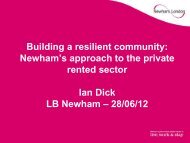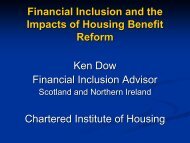View publication - Chartered Institute of Housing
View publication - Chartered Institute of Housing
View publication - Chartered Institute of Housing
Create successful ePaper yourself
Turn your PDF publications into a flip-book with our unique Google optimized e-Paper software.
THE ‘RIGHT STUFF’ FOR LEADERS IN SOCIAL HOUSING<br />
b) The solution can be implemented by the exertion <strong>of</strong> authority.<br />
c) The solution is easily accepted and leads to a lowering <strong>of</strong> conflict among<br />
stakeholders.<br />
d) The solution restores equilibrium and leads to on-going stakeholder satisfaction.<br />
Within social housing, it would appear that many solutions proposed and implemented<br />
by leadership teams were based on the presumptions <strong>of</strong> ‘technical leadership’ – a<br />
solution exists and can restore confidence and drive progress. By adopting leadership<br />
actions such as: short-term fixes, tightening <strong>of</strong> controls and restructuring, we create an<br />
appearance <strong>of</strong> the return <strong>of</strong> normalcy. This is an illusion that many leaders will recognise<br />
and seek some solace within.<br />
However, as Heifetz and his colleagues point out, there are some pretty obvious<br />
indicators that technical leadership has been inappropriate. Clues include:<br />
a) The same problem keeps re-surfacing.<br />
b) There is resistance among stakeholders and you don’t really understand why.<br />
c) People behave as if ‘the world is going to end’!<br />
d) (And, perhaps most tellingly) you feel incompetent.<br />
The ‘Right Stuff’ for social housing leadership<br />
If you have skipped down to this section looking for prescriptive action points, you<br />
should read the previous section! The time constrained drive to find a solution is actually<br />
part <strong>of</strong> the leadership problem we can sometimes see within the sector. Chua et al<br />
(2011) refer to the ‘whiplash’ effect created by shorter electoral cycles and a pressure to<br />
engage in ‘change for changes sake’.<br />
Heifetz and his colleagues put forward the term ‘adaptive leadership’ to describe the<br />
challenges facing individuals who wish to take on the challenge <strong>of</strong> providing<br />
organisational direction. At its highest level <strong>of</strong> abstraction, adaptive leadership can be<br />
distilled into four broad themes <strong>of</strong> leadership effectiveness:<br />
1. Confrontation and prototyping – In his book, Good To Great, Jim Collins (2001)<br />
refers to leaders that are willing to challenge the status quo by focusing on ‘turning<br />
over rocks and looking at all <strong>of</strong> the squiggly things underneath... even if what you<br />
see can scare the hell out <strong>of</strong> you’(p.72). The challenge is not just to recognise the<br />
problem. Given that there are no ‘easy’ answers, leaders need to recognise that<br />
67

















